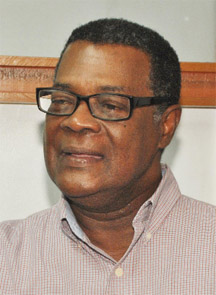The Guyana Gold and Diamond Miners Association (GGDMA) has set the mining industry a production target of 400,000 ounces in 2012, the year in which the association is celebrating its thirtieth anniversary. And according to GGDMA President Patrick Harding the industry has every confidence that with the support of the various stakeholders, primarily the government of Guyana, the target can be achieved. Last year, some 363,000 ounces of gold were sold to the Guyana Gold Board and this year’s production target represents a 10 per cent increase over 2011.
Harding told Stabroek Business that increased production targets pointed to the ever rising importance of gold in the Guyana economy. Earnings from the precious metal now contribute more to the Guyana economy than sugar, rice and forestry, together. Harding disclosed that the mining industry currently services more than 100,000 Guyanese and that the industry is also a major supporter of the country’s air, land and sea transport services.
Several prominent local companies including MACORP, T Geddes Grant Ltd GENEQUIP Parts and Supplies, JOHIL, Crown Mining and JAPARTS are suppliers to the gold-mining industry. Harding noted too that several major food distributors and retail outlets in the city and in various other townships and communities had developed business relationships with the mining community.

And in the wake of charges made by Natural Resources Minister Robert Persaud regarding the smuggling of gold out of Guyana, the GGDMA president said his organisation continued to encourage miners to sell their gold to the Guyana Gold Board and to licensed buyers but pointed out that the miner cannot be blamed for not selling his gold to the board if it is not functioning effectively. Harding said that during this year the Bartica branch of the Gold Board has not been functioning effectively, forcing miners to sell their gold to other buyers resulting in a significant drop in gold sales to the Board. The association is urging the board to “get its act together”.
However, Harding told Stabroek Business that despite the optimism in the industry that its 2012 target will be met, there were some immediate problems facing small and medium scale miners, which required solutions. In this regard, Harding said, deficient roads and infrastructure and issues of crime and security were high on the list of concerns of the miners. With regard to infrastructure, Harding said, the GGDMA was now represented on a new Hinterland Roads and Infrastructure Committee charged with examining among other things, hinterland roads, airports and bridges that support miners seeking to reach their work sites and in pursuit of the opening up of new mining areas.
On the issue of crime and security, Harding said the GGDMA and the mining community continued to dialogue with the police on ways and methods of combatting what he conceded was a deeply worrying crime situation in the interior. Drugs and prostitution are also reportedly very prevalent in mining areas. Harding said discussions with the police had also centred around the setting up of new police outposts, the creation of roving patrols and the creation of private security forces for larger mining operations.
Harding said one of the operational challenges which the industry would have to consider in the short term would be finding a substitute for mercury next year when the sale of the substance is banned worldwide. He pointed out that up until now the survival of the industry depended on the use of mercury though alternative gold recovery methods including floatation and the Knelson Concentration method were being studied. He said the GGDMA and the Guyana Geology and Mines Commission were currently collaborating on adjustments to the design of sluice boxes in order to secure a higher than the current 35%-45% gold recovery rate.
Meanwhile, according to Harding, the GGDMA considered the recently concluded lottery for lands for mining a success and it expected that more lands which had been set aside for lottery and auction since 2009 will be opened up this year.
Harding told Stabroek Business that despite having set itself a new and higher production target than in previous years, the industry expected that 2012 could be a testing one. He pointed out that very shortly it will become necessary for small and medium-scale miners to conduct exploration exercises on their properties if they are to continue mining. “These are costly exercises. It could cost the owner of a medium-scale operation up to around US$1million to conduct such an operation. “Exploration can be a helpful tool but the cost can be prohibitive,” Harding said. He said that the GGDMA is exploring various ways of helping to facilitate those exploration efforts including sounding out diplomatic missions on the possibility of securing overseas assistance.
Meanwhile, the GGDMA will also have to face the challenge of helping to train new entrants into the sector including investors who just acquired land under the recently concluded lottery. “Year 2012 brings the challenge to all miners to mine with the environment in mind and to ensure that mining operations are being worked in accordance with the mining laws and regulations and the environmental laws and regulations,” Harding said.




